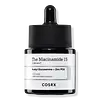What's inside
What's inside
 Key Ingredients
Key Ingredients

 Benefits
Benefits

 Concerns
Concerns

No concerns
 Ingredients Side-by-side
Ingredients Side-by-side

Salicylic Acid 3%
MaskingWater
Skin ConditioningHydroxyethyl Urea
HumectantPetrolatum
EmollientAminomethyl Propanol
BufferingGlycerin
HumectantDimethicone
EmollientGluconolactone
Skin ConditioningSteareth-21
CleansingJojoba Esters
EmollientGlyceryl Stearate
EmollientStearyl Alcohol
EmollientAloe Barbadensis Leaf Juice
Skin ConditioningHydroxyethyl Acrylate/Sodium Acryloyldimethyl Taurate Copolymer
Emulsion StabilisingButyrospermum Parkii Butter Extract
Skin ConditioningMethyl Gluceth-20
Humectant7-Dehydrocholesterol
Emulsion StabilisingBisabolol
MaskingCeteareth-25
CleansingZea Mays Oil
EmulsifyingZingiber Officinale Root Extract
MaskingCeramide NP
Skin ConditioningHydrolyzed Jojoba Esters
Skin ConditioningCetearyl Alcohol
EmollientStearamidopropyl Pg-Dimonium Chloride Phosphate
Magnesium Ascorbyl Phosphate
AntioxidantPanthenol
Skin ConditioningTocopheryl Acetate
AntioxidantCeramide EOP
Skin ConditioningPentylene Glycol
Skin ConditioningCeramide Eos
Skin ConditioningBis-Lauryl Cocaminopropylamine/Hdi/PEG-100 Copolymer
Cholesterol
EmollientPropylene Glycol
HumectantCaprooyl Phytosphingosine
Skin ConditioningPolysorbate 60
EmulsifyingCeramide Ns
Skin ConditioningCetyl Alcohol
EmollientIsohexadecane
EmollientEthylhexylglycerin
Skin Conditioning4-T-Butylcyclohexanol
MaskingCeramide AP
Skin ConditioningEDTA
Behenic Acid
CleansingButylene Glycol
HumectantCaprooyl Sphingosine
Skin ConditioningMethylparaben
PreservativeTocopherol
AntioxidantSalicylic Acid 3%, Water, Hydroxyethyl Urea, Petrolatum, Aminomethyl Propanol, Glycerin, Dimethicone, Gluconolactone, Steareth-21, Jojoba Esters, Glyceryl Stearate, Stearyl Alcohol, Aloe Barbadensis Leaf Juice, Hydroxyethyl Acrylate/Sodium Acryloyldimethyl Taurate Copolymer, Butyrospermum Parkii Butter Extract, Methyl Gluceth-20, 7-Dehydrocholesterol, Bisabolol, Ceteareth-25, Zea Mays Oil, Zingiber Officinale Root Extract, Ceramide NP, Hydrolyzed Jojoba Esters, Cetearyl Alcohol, Stearamidopropyl Pg-Dimonium Chloride Phosphate, Magnesium Ascorbyl Phosphate, Panthenol, Tocopheryl Acetate, Ceramide EOP, Pentylene Glycol, Ceramide Eos, Bis-Lauryl Cocaminopropylamine/Hdi/PEG-100 Copolymer, Cholesterol, Propylene Glycol, Caprooyl Phytosphingosine, Polysorbate 60, Ceramide Ns, Cetyl Alcohol, Isohexadecane, Ethylhexylglycerin, 4-T-Butylcyclohexanol, Ceramide AP, EDTA, Behenic Acid, Butylene Glycol, Caprooyl Sphingosine, Methylparaben, Tocopherol
 Reviews
Reviews

Ingredients Explained
These ingredients are found in both products.
Ingredients higher up in an ingredient list are typically present in a larger amount.
Butylene Glycol (or BG) is used within cosmetic products for a few different reasons:
Overall, Butylene Glycol is a safe and well-rounded ingredient that works well with other ingredients.
Though this ingredient works well with most skin types, some people with sensitive skin may experience a reaction such as allergic rashes, closed comedones, or itchiness.
Learn more about Butylene GlycolEthylhexylglycerin (we can't pronounce this either) is commonly used as a preservative and skin softener. It is derived from glyceryl.
You might see Ethylhexylglycerin often paired with other preservatives such as phenoxyethanol. Ethylhexylglycerin has been found to increase the effectiveness of these other preservatives.
Pentylene glycol is typically used within a product to thicken it. It also adds a smooth, soft, and moisturizing feel to the product. It is naturally found in plants such as sugar beets.
The hydrophilic trait of Pentylene Glycol makes it a humectant. As a humectant, Pentylene Glycol helps draw moisture from the air to your skin. This can help keep your skin hydrated.
This property also makes Pentylene Glycol a great texture enhancer. It can also help thicken or stabilize a product.
Pentylene Glycol also acts as a mild preservative and helps to keep a product microbe-free.
Some people may experience mild eye and skin irritation from Pentylene Glycol. We always recommend speaking with a professional about using this ingredient in your routine.
Pentylene Glycol has a low molecular weight and is part of the 1,2-glycol family.
Learn more about Pentylene GlycolTocopherol (also known as Vitamin E) is a common antioxidant used to help protect the skin from free-radicals and strengthen the skin barrier. It's also fat soluble - this means our skin is great at absorbing it.
Vitamin E also helps keep your natural skin lipids healthy. Your lipid skin barrier naturally consists of lipids, ceramides, and fatty acids. Vitamin E offers extra protection for your skin’s lipid barrier, keeping your skin healthy and nourished.
Another benefit is a bit of UV protection. Vitamin E helps reduce the damage caused by UVB rays. (It should not replace your sunscreen). Combining it with Vitamin C can decrease sunburned cells and hyperpigmentation after UV exposure.
You might have noticed Vitamin E + C often paired together. This is because it is great at stabilizing Vitamin C. Using the two together helps increase the effectiveness of both ingredients.
There are often claims that Vitamin E can reduce/prevent scarring, but these claims haven't been confirmed by scientific research.
Learn more about TocopherolWater. It's the most common cosmetic ingredient of all. You'll usually see it at the top of ingredient lists, meaning that it makes up the largest part of the product.
So why is it so popular? Water most often acts as a solvent - this means that it helps dissolve other ingredients into the formulation.
You'll also recognize water as that liquid we all need to stay alive. If you see this, drink a glass of water. Stay hydrated!
Learn more about Water